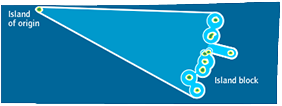The Canoe Is the People
Indigenous Navigation in the Pacific
Finding Land

On a clear day, low islands can be seen from about 15 km away and high islands from even further away. Signs of land can normally be seen or felt from 30 km away or more. The signs include sea life, interrupted swells GLOSSARY interrupted - broken , clouds, and te lapa (deep phosphorescence).
A wayfinder uses these signs to increase the size of the destination island. It is easier to head for an area of about 60 km in diameter GLOSSARY diameter - distance from one side of ta circle to the other instead of just the small island. The wayfinder can then read the signs to find land. The enlarged islands join together to form island blocks, which can be hundreds of kilometres wide.
For each island, the signs differ, and the navigator reads them differently. At night, if wayfinders do not know the area well, they may drop the sail and wait till morning before heading for land. When landing they may often have to sail into the wind and the current GLOSSARY current - the directional flow of the sea .
After a long voyage or fishing trip, there is usually a big welcome to celebrate a vaka’s safe return as well as the supplies and food that it may bring.
When we saw them, we knew we had permission to sail
Cook Islander Dorice Reid, crew member of Te Au o Tonga on the voyage to Taputapuatea Marae in 1995
“Cook Islander Dorice Reid, crew member of Te Au o Tonga on the voyage to Nuku Hiva, Te Henua Enana (Marquesas Islands) in 1995: The sky was full of birds. They were flying up and down as if they were celebrating. And at the same time as we sailed into this harbour, the water of the harbour was absolutely awash with fish. Hundreds of dolphins were swimming and leaping in the harbour entrance. So, here we had three phases of living things celebrating. We had man on the beach with drums and dancing, and we had birds in the sky flying up and down in huge celebration, and we had the fish. We had the fish in the harbour.”






